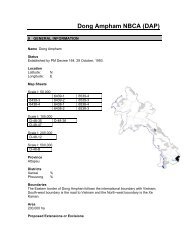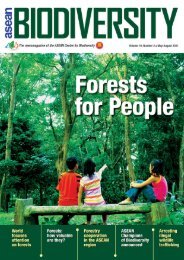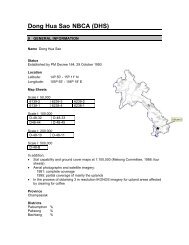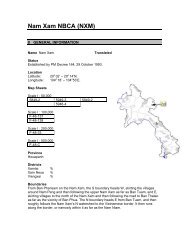Xe Sap NBCA (XS) Name Xe Sap. Abbreviated: XSP Status ...
Xe Sap NBCA (XS) Name Xe Sap. Abbreviated: XSP Status ...
Xe Sap NBCA (XS) Name Xe Sap. Abbreviated: XSP Status ...
You also want an ePaper? Increase the reach of your titles
YUMPU automatically turns print PDFs into web optimized ePapers that Google loves.
<strong>Xe</strong> <strong>Sap</strong> <strong>NBCA</strong> (<strong>XS</strong>)<br />
GENERAL INFORMATION<br />
<strong>Name</strong><br />
<strong>Xe</strong> <strong>Sap</strong>. <strong>Abbreviated</strong>: <strong>XS</strong>P<br />
<strong>Status</strong> Established by PM Decree 210, February 1996<br />
Location<br />
Latitude: 15°56’40” - 16°19’0”N Longitude: 106°41’40’’ - 107°28’0”E<br />
Map Sheets Scale I: 50,000<br />
6341 I 6441 IV 6441 I<br />
6341 II 6441 III 6441 II<br />
63441 I 6440 IV 6440 I<br />
Scale I: 100,000<br />
E 48 – 142 E 48 - 143<br />
D 48 - 10 D 48 - 11<br />
Scale I: 200,000<br />
ND 48 - 4<br />
Scale I: 1,000,000<br />
E 48<br />
D 48<br />
Provinces<br />
Districts<br />
Salavan & <strong>Xe</strong> Kong<br />
Samuoy [Salavan]<br />
Ta-Oy [Salavan]<br />
Kaleum [<strong>Xe</strong> Kong]<br />
Perimeter<br />
Boundaries<br />
The eastern boundary follows the border with Vietnam.<br />
The southern boundary follows the rivers Nam Talon, <strong>Xe</strong> Lon and <strong>Xe</strong> Kong till the<br />
village Ban Talouy Gnai. Approximately 4 km south of Ban Talouy Gnai the <strong>NBCA</strong><br />
boundary leaves the <strong>Xe</strong> Kong and proceeds west along the mountain slopes towards the<br />
southern loop of the <strong>Xe</strong> Lanong.<br />
The western and northern boundary of the <strong>NBCA</strong> run mainly where the mountain<br />
slopes start to rise from the undulating land of the river valleys. The western boundary<br />
skirts the villages below the slopes east of Muang Ta-Oy running about 2 km east of<br />
Houay Takan till it reaches Huoay Tanghak. Here it turns eastwards. The northern<br />
boundary remains south of but adjacent to the road leading from Ta-Oy to Samuoy and<br />
reaches the Vietnamese border south of the national border crossing at Dane Dalai.<br />
Area<br />
1335 km2 (Reference: Protected Area Fact-Sheets, Annex 3 to the Mid-1995 <strong>Status</strong><br />
Report on Protected Area System Planning and Management in Lao PDR, Forest<br />
Resources Conservation Sub-Programme of the Lao-Swedish Forestry Cooperation<br />
Programme, IUCN).
1498 km2 (Calculated by the Forest Cover Monitoring Project MRC/GTZ)<br />
Proposed<br />
Extensions<br />
Access<br />
The main access is by the unpaved road leading from Salavan to Ta-Oy and further east<br />
to Samuoy. This road runs along the northern side of <strong>Xe</strong> <strong>Sap</strong> <strong>NBCA</strong>, but it does not pass<br />
through the <strong>NBCA</strong> area. From this road, small access tracks lead to villages situated on<br />
the northern periphery and inside the northern part of the <strong>NBCA</strong>.<br />
To the southeastern part of <strong>Xe</strong> <strong>Sap</strong> <strong>NBCA</strong> the access is very difficult. It is best by boat<br />
on the <strong>Xe</strong> Kong and its two major tributaries <strong>Xe</strong> <strong>Sap</strong> and <strong>Xe</strong> Lon, or it is a few days<br />
walk to reach the <strong>NBCA</strong>.<br />
Stakeholder<br />
Villages and<br />
Population<br />
Due to lack of information and the fact that the Land and Forest Allocation has not yet<br />
been implemented in most of the area, it is only possible to distinguish two types of<br />
villages:<br />
I. Villages situated inside <strong>Xe</strong> <strong>Sap</strong> <strong>NBCA</strong><br />
II. Villages situated in the surroundings of <strong>Xe</strong> <strong>Sap</strong> <strong>NBCA</strong>.<br />
Principal Local<br />
Resource<br />
Uses<br />
The numbers of persons are the data of the National Population Census 1995 conducted<br />
by the State Planning Committee of the National Statistical Centre.<br />
District Inside <strong>NBCA</strong> Surroundings <strong>Xe</strong> <strong>Sap</strong> <strong>NBCA</strong> Total No. persons<br />
Villages Persons Villages Persons<br />
Ta-Oy 3 640 25 8.273 8.913<br />
Samuoy 11 2.397 10 1.667 4.064<br />
Kaleum∗ 3 345 11 1.348 1.693<br />
Total 17 3.382 46 11.288 14.670<br />
∗ For Kaleum District the population data are not complete. The <strong>NBCA</strong> staff listed<br />
village names, which could not be found in the lists of the National Population Census<br />
of 1995.
Ethnic<br />
Composition<br />
District Ethnic Group Inside <strong>NBCA</strong> Surroundings <strong>NBCA</strong> Total No. persons<br />
Villages Persons Villages Persons<br />
Pako 2 379 8 2.810 3.189<br />
Ta-Oy Ta-Oy 1 261 8 2.732 2.993<br />
Samuoy<br />
Katang 9 2.731 2.731<br />
Pako 9 1.999 10 1.657 3.656<br />
Katang 2 322 322<br />
Katu Part of one village 76<br />
Kaleum∗ Katu 2 345 6 1.057 1.402<br />
Ngae 2 291 291<br />
BRIEF HISTORY<br />
ECOLOGY<br />
∗ For four villages in Kaleum District the data are missing.<br />
Since October 1996, the Forest Management and Conservation Programme<br />
(FOMACOP), a joint undertaking of the Government of Lao PDR (GoL), the<br />
International Development Association (IDA) of the World Bank (WB), the Global<br />
Environmental Facility (GEF), and the Government of Finland through FINNIDA, has<br />
been assisting the Lao government in the Management of <strong>Xe</strong> <strong>Sap</strong> <strong>NBCA</strong>.<br />
Physical<br />
Features<br />
Elevation<br />
Climate<br />
The <strong>NBCA</strong>, which forms part of the Southern Annamite Mountains, is mostly steep<br />
terrain with high plateaus at about 1400 m asl. There are very steep faces on the<br />
eastern and southern sides rising from 400 m to 1400 m asl. The highest peak called<br />
Dong Be is 2066 m asl.<br />
Altitude between 400 and 2066m above sea level<br />
<strong>Xe</strong> <strong>Sap</strong> <strong>NBCA</strong> lays in the Southeast Asia monsoon climate. During the winter<br />
(November – February), when the sun is to the south of the equator the climate is under<br />
the influence of the cold continental high-pressure region over China. The winds are<br />
clockwise around the high and come from the northeast over Southeast Asia. This is the<br />
Northeast Monsoon, characterized by cold dry air and infrequent light rain.<br />
For the summer (May – August), the sun is to the north of the equator and heats the<br />
landmass beneath to a degree that causes an extensive low-pressure region called<br />
Intertropical Convergence Zone and the Monsoon Trough. Warm winds from the<br />
southwest carry moisture from the Andaman Sea and the Gulf of Thailand to the part of<br />
the trough in the Lao PDR region where vertical convection causes rainfall, large<br />
amounts during the height of the monsoon season. This is the Southwest Monsoon. The<br />
air is warm, and humidity high.<br />
Main Forest<br />
Types<br />
Hill Evergreen Forest (dominant)<br />
Semi – Evergreen Forest
Pine Forest<br />
Forest<br />
Cover<br />
This calculation was realized by the Forest Cover Monitoring Project (FCMP)<br />
MRC/GTZ. It is based on interpretation of 1996/97 Landsat TM with the <strong>NBCA</strong><br />
boundaries as shown on topographical maps 1:100 000 provided by FOMACOP project.<br />
Verification with the original documents has not taken place. Therefore the data might<br />
be only approximate.<br />
Forest Code Area / ha % of Total Area<br />
Evergreen / Mixed, Continuous Cover, High 58.499 39.1<br />
Cover Density (11,17)<br />
Evergreen / Mixed, Continuous Cover, Medium 53.577 35.8<br />
Cover Density (12, 18)<br />
Evergreen / Mixed, Mosaic (13, 19) 10.336 6.9<br />
Deciduous Continuous Cover (20) 368 0.2<br />
Regrowth (40) 2.897 1.9<br />
Evergreen Wood and Shrub Land (61, 63, 65) 22.009 14.7<br />
Grassland (62) 1.797 1.2<br />
Dry Wood and Shrub Land (64) 166 0.1<br />
Mosaic of Cropping (81, 82) 173 0.1<br />
Grand Total 149.822 100%<br />
Other Habitat<br />
Features<br />
Recorded<br />
Vertebrates<br />
Numerous water falls<br />
Some mountains have rocky cliff faces.<br />
Rhododendron forests at high elevations<br />
Vertebrate Class No. of Species Key Species<br />
Mammals 43 6<br />
Birds 178 19<br />
Reptiles 48 new species∗<br />
Amphibians 33 new species∗<br />
Fish no data no data<br />
∗ Not yet described<br />
EVALUATION<br />
Principal Contributions to the <strong>NBCA</strong> System<br />
Biodiversity<br />
Values<br />
Nationally significant population of two species of bears<br />
Regionally significant population of gaur, one of the more important species for<br />
conservation<br />
Significant population of dholes
Significant population of Serow<br />
At least one species of Muntjac, large antlered Muntjac<br />
Presence of tigers<br />
Pine Forest and Hill Evergreen Forest here support Pinus dalatensis, a species of pine<br />
previously thought to be endemic to Vietnam, and Kinabaluchloa sp., a genus of bamboo<br />
not previously recorded from Lao or Vietnam (only provisionally identified).<br />
Because of it’s geographical position in the Southern Annamites, it’s altitude range and<br />
variation, and it’s undisturbed old-growth evergreen forest types, as well it’s extensive<br />
areas of high elevation, <strong>Xe</strong> <strong>Sap</strong> has unique importance in the <strong>NBCA</strong> system in Lao PDR.<br />
Watershed<br />
Values<br />
Two major watersheds:<br />
Northwards encompassing <strong>Xe</strong> Lanong and <strong>Xe</strong> Pon rivers, which flow into the <strong>Xe</strong><br />
Banghiang<br />
Southwards with <strong>Xe</strong> Lon and <strong>Xe</strong> <strong>Sap</strong> rivers as the main tributaries flowing into the <strong>Xe</strong><br />
Kong river<br />
Both are important watershed systems supporting human communities as well as<br />
biodiversity and endangered wildlife species. In the <strong>Xe</strong> Kong River, e.g., live at least<br />
part of the year Irrawaddy Dolphins, one of the most endangered species of Lao PDR.<br />
The <strong>Xe</strong> Banghiang, which is bordering Dong Phou Vieng <strong>NBCA</strong> is known for its wealth<br />
in fish with respect to species diversity and quantity.<br />
Cultural<br />
Values<br />
Indigenous Lao Theung culture with strong spiritual ties to the land<br />
Five different “Lao Theung” languages are spoken in the <strong>NBCA</strong>, of which at least one is<br />
in danger of extinction.<br />
Many funeral and sacred forests<br />
Indochina War relicts<br />
Part of the Ho Chi Min Trail<br />
Security<br />
Values<br />
Recreation and<br />
Tourism<br />
Values<br />
Principal<br />
Threats<br />
International animal trade encouraging the poaching of animals from the <strong>NBCA</strong><br />
Unsustainable resource use by outsiders, e.g. over-harvesting of rattan<br />
Upgraded road and bridges on the north side of the <strong>NBCA</strong> leading to increased<br />
unsustainable resource use in some areas.<br />
Increased human population causing further clearings for crops.
Reasons for<br />
Extensions or<br />
Excisions<br />
CURRENT MANAGEMENT<br />
Contact<br />
Staffing<br />
Mr. Bounthong Outensakda<br />
Manager of <strong>Xe</strong> <strong>Sap</strong> National Biodiversity Conservation Area<br />
Forest Management and Conservation Programme (FOMACOP)<br />
National Biodiversity Conservation Areas Management Sub–Programme<br />
Provincial Agricultural and Forestry Office (PAFO)<br />
Salavan, Salavan Province; Tel: 034 – 211 068<br />
Staff is from the Province Agriculture and Forestry Office (PAFO) and the District<br />
Agriculture and Forestry Office (DAFO).<br />
A United Nations Volunteer (UNV) started as Conservation Management and<br />
Operations Advisor in February 1999.<br />
Province District Men Women Total<br />
Salavan 2 1 3<br />
Salavan Ta-Oy 7 2 9<br />
Salavan Samuoy 8 2 10<br />
<strong>Xe</strong> Kong 8 8<br />
<strong>Xe</strong> Kong Kaleum 2 2<br />
Total 27 5 32<br />
Organization<br />
Buildings<br />
Equipment<br />
Provincial offices in Salavan and <strong>Xe</strong> Kong (with PAFO)<br />
Field stations including offices and dormitories in Ta-Oy and Samuoy districts<br />
Two 4WD vehicles<br />
Five motorcycles<br />
Current<br />
Management<br />
Priorities<br />
Training of staff<br />
Development of procedures for:<br />
Patrolling<br />
Monitoring<br />
Participatory management of natural resources by the local villagers<br />
Other<br />
Management<br />
Opportunities<br />
Development of sustainable practices for NTFP use by the local villagers<br />
Development of small scale enterprises<br />
Development of tourism based on the tourist values of:
Landscape<br />
Undisturbed nature<br />
Rare “exotic” animals and plants<br />
Authentic indigenous cultures<br />
Historical war relicts<br />
Participation of local villagers in monitoring of:<br />
Wildlife populations<br />
Habitat changes<br />
Trends in NTFP presence<br />
Trends in NTFP use<br />
Poaching<br />
Documentation of the indigenous knowledge<br />
Stabilization of Slash and Burn Agriculture<br />
Coordination of the biodiversity conservation efforts with the corresponding Vietnamese<br />
institutions on the other side of the border.<br />
Other Relevant<br />
Project<br />
Initiatives<br />
Development Activities implemented by the Forest Management<br />
and Conservation Project (FOMACOP)<br />
Construction of a village school in Ban Kappe, Ta-Oy District<br />
Training of village health workers in Birth Spacing and Primary Village Health<br />
Care in Ta-Oy District for Ban Kappe and Ban Sanang.<br />
Mines Advisory Group (MAG): unexploded ordinance (in Ta-0y and Samuoy districts,<br />
Salavan province)<br />
Medecins Sans Frontieres (MSF): improve the health situation for the minorities (in<br />
Kaleum district, <strong>Xe</strong> Kong province)<br />
REPORTS AND PUBLICATIONS<br />
Caffery, B. (1999). Conservation and Development. Final report of the period of<br />
consultancy from 8.9.1997 to 11.6.1999. FOMACOP (76 pp.).<br />
Costello, N. A. and Sulavan, K. (1993). Katu Folktales and Society. Ministry of<br />
Information and Culture. Institute of Research on Lao Culture and Society.<br />
Duckworth, J. W. (1997). Small Carnivores in Laos: A <strong>Status</strong> Review with Notes on<br />
Ecology, Behavior and Conservation. Small Carnivore Conservation, The Newsletter<br />
and Journal of the IUCN / SSC Mustelid, Viverrid & Procyonid Specialist Group, 16, 1 –<br />
21.<br />
Duckworth, J. W. (1997). A Survey of Large Animals in the Central Annamite<br />
Mountains of Laos. International Journal of Mammalian Biology, 63: 239 – 250.<br />
Duckworth, J. W., Timmins, R. J. and Evans, T.D. (1997).The Conservation <strong>Status</strong> of<br />
the River Lapwing Vanellus duvaucelii in Southern Laos. Biological Conservation, 84<br />
(3): 215 – 222<br />
Falke, M. (1999). The Geological Conditions of <strong>Xe</strong> <strong>Sap</strong> National Biodiversity<br />
Conservation Area, Salavan and <strong>Xe</strong> Kong Provinces (4 pp.).
Johnston, J. B. (1999). Inception Report: Conservation Advisor, <strong>Xe</strong> <strong>Sap</strong> <strong>NBCA</strong>.<br />
FOMACOP National Statistical Centre, State Planning Committee (1999). Population<br />
Census Results 1995, Saravan Province, Districts: Taoy and Samuoy, Se Kong Province,<br />
District: Kaleum.<br />
(These data, which are available normally only on diskette, have been printed out for <strong>Xe</strong><br />
<strong>Sap</strong> <strong>NBCA</strong>)<br />
Robichaud, W. G. (1998). Physical and Behavioral Description of a Captive Soala,<br />
Pseudoryx nghetinhensis. Journal of Mammology, 79 (2): 394 – 405.<br />
Schaller, G.B. (1995). A Wildlife Survey in the Annamite Mountains of Laos, Dec. 1994<br />
–Jan. 1995. Unpublished report to the Wildlife Conservation Society, Vientiane.<br />
Schaller, G.B. (1995). A preliminary survey of the northern <strong>Xe</strong> <strong>Sap</strong> region, Salavan<br />
Province, April<br />
25 – May 11, 1996. Unpublished field report. Wildlife Conservation Society.<br />
Showler, D. A., Davidson, P., Vongkhamheng, C. and Salivong, K. (1998). A Wildlife<br />
and Habitat Survey of the Southern Border of <strong>Xe</strong> <strong>Sap</strong> National Biodiversity<br />
Conservation Area and the Dakchung Plateau, <strong>Xe</strong> Kong Province, Lao PDR. Final<br />
Report. Centre for Protected Areas and Watershed Management / Wildlife Conservation,<br />
Society Cooperative Program, Department of Forestry, Ministry of Agriculture and<br />
Forestry, Lao PDR. WCS Wildlife Conservation Society.<br />
Steinmetz, R., Stones, I. and Chan-Ard, T. (1999). An Ecological Survey of Habitats,<br />
Wildlife and People in <strong>Xe</strong> <strong>Sap</strong> <strong>NBCA</strong>. WWF Thailand.<br />
Sulavan, K. and Costello, N. A. (1994). Belief and Practice in Katu Agriculture. The<br />
Ministry for Education and Culture. The Institute of Research on Lao Culture.<br />
Sulavan, Khamluan, T. Kingsada and N. A. Costello (1994). Aspects of Katu Traditional<br />
Medicine. Ministry of Information and Culture. Institute of Research on Lao Culture<br />
(534 pp.).<br />
Sulavan, K, Kingsada, T. and Costello, N. A. (1996). Katu Traditional Education for<br />
Daily Life in Ancient Times. The Ministry for Education and Culture. The Institute of<br />
Research on Lao Culture.<br />
Timmins, R. J., Evans, T. D., Khounboline, K. and Sisomphone, C. (1998). <strong>Status</strong> and<br />
Conservation of the giant Muntjac Megamuntiacus vuquangensis, and notes on other<br />
Muntjac species in Laos. Oryx 32(1): 59 – 67.<br />
Timmins, R. J. and Vongkhamheng, C. (1996). A Preliminary Wildlife and Habitat<br />
Survey of <strong>Xe</strong> <strong>Sap</strong> National Biodiversity Conservation Area and the Mountains to the<br />
South, Salavan Province, Lao PDR. Wildlife Conservation Society New York.<br />
Wagenbreth, I. and Vongsaly, S. (1999). <strong>Xe</strong> <strong>Sap</strong> National Biodiversity Conservation<br />
Area, Population Census Data 1995 (9 pp.).











